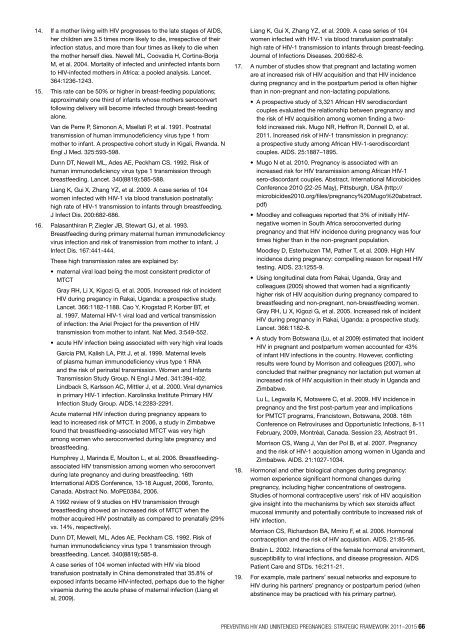PREVENTING HIV AND UNINTENDED PREGNANCIES ... - UNFPA
PREVENTING HIV AND UNINTENDED PREGNANCIES ... - UNFPA
PREVENTING HIV AND UNINTENDED PREGNANCIES ... - UNFPA
- No tags were found...
You also want an ePaper? Increase the reach of your titles
YUMPU automatically turns print PDFs into web optimized ePapers that Google loves.
14. If a mother living with <strong>HIV</strong> progresses to the late stages of AIDS,her children are 3.5 times more likely to die, irrespective of theirinfection status, and more than four times as likely to die whenthe mother herself dies. Newell ML, Coovadia H, Cortina-BorjaM, et al. 2004. Mortality of infected and uninfected infants bornto <strong>HIV</strong>-infected mothers in Africa: a pooled analysis. Lancet.364:1236-1243.15. This rate can be 50% or higher in breast-feeding populations;approximately one third of infants whose mothers seroconvertfollowing delivery will become infected through breast-feedingalone.Van de Perre P, Simonon A, Msellati P, et al. 1991. Postnataltransmission of human immunodeficiency virus type 1 frommother to infant. A prospective cohort study in Kigali, Rwanda. NEngl J Med. 325:593-598.Dunn DT, Newell ML, Ades AE, Peckham CS. 1992. Risk ofhuman immunodeficiency virus type 1 transmission throughbreastfeeding. Lancet. 340(8819):585-588.Liang K, Gui X, Zhang YZ, et al. 2009. A case series of 104women infected with <strong>HIV</strong>-1 via blood transfusion postnatally:high rate of <strong>HIV</strong>-1 transmission to infants through breastfeeding.J Infect Dis. 200:682-686.16. Palasanthiran P, Ziegler JB, Stewart GJ, et al. 1993.Breastfeeding during primary maternal human immunodeficiencyvirus infection and risk of transmission from mother to infant. JInfect Dis. 167:441-444.These high transmission rates are explained by:• maternal viral load being the most consistent predictor ofMTCTGray RH, Li X, Kigozi G, et al. 2005. Increased risk of incident<strong>HIV</strong> during pregancy in Rakai, Uganda: a prospective study.Lancet. 366:1182-1188. Cao Y, Krogstad P, Korber BT, etal. 1997. Maternal <strong>HIV</strong>-1 viral load and vertical transmissionof infection: the Ariel Project for the prevention of <strong>HIV</strong>transmission from mother to infant. Nat Med. 3:549-552.• acute <strong>HIV</strong> infection being associated with very high viral loadsGarcia PM, Kalish LA, Pitt J, et al. 1999. Maternal levelsof plasma human immunodeficiency virus type 1 RNAand the risk of perinatal transmission. Women and InfantsTransmission Study Group. N Engl J Med. 341:394-402.Lindback S, Karlsson AC, Mittler J, et al. 2000. Viral dynamicsin primary <strong>HIV</strong>-1 infection. Karolinska Institute Primary <strong>HIV</strong>Infection Study Group. AIDS.14:2283-2291.Acute maternal <strong>HIV</strong> infection during pregnancy appears tolead to increased risk of MTCT. In 2006, a study in Zimbabwefound that breastfeeding-associated MTCT was very highamong women who seroconverted during late pregnancy andbreastfeeding.Humphrey J, Marinda E, Moulton L, et al. 2006. Breastfeedingassociated<strong>HIV</strong> transmission among women who seroconvertduring late pregnancy and during breastfeeding. 16thInternational AIDS Conference, 13-18 August, 2006, Toronto,Canada. Abstract No. MoPE0384, 2006.A 1992 review of 9 studies on <strong>HIV</strong> transmission throughbreastfeeding showed an increased risk of MTCT when themother acquired <strong>HIV</strong> postnatally as compared to prenatally (29%vs. 14%, respectively).Dunn DT, Mewell, ML, Ades AE, Peckham CS. 1992. Risk ofhuman immunodeficiency virus type 1 transmission throughbreastfeeding. Lancet. 340(8819):585-8.A case series of 104 women infected with <strong>HIV</strong> via bloodtransfusion postnatally in China demonstrated that 35.8% ofexposed infants became <strong>HIV</strong>-infected, perhaps due to the higherviraemia during the acute phase of maternal infection (Liang etal, 2009).Liang K, Gui X, Zhang YZ, et al. 2009. A case series of 104women infected with <strong>HIV</strong>-1 via blood transfusion postnatally:high rate of <strong>HIV</strong>-1 transmission to infants through breast-feeding.Journal of Infections Diseases. 200:682-6.17. A number of studies show that pregnant and lactating womenare at increased risk of <strong>HIV</strong> acquisition and that <strong>HIV</strong> incidenceduring pregnancy and in the postpartum period is often higherthan in non-pregnant and non-lactating populations.• A prospective study of 3,321 African <strong>HIV</strong> serodiscordantcouples evaluated the relationship between pregnancy andthe risk of <strong>HIV</strong> acquisition among women finding a twofoldincreased risk. Mugo NR, Heffron R, Donnell D, et al.2011. Increased risk of <strong>HIV</strong>-1 transmission in pregnancy:a prospective study among African <strong>HIV</strong>-1-serodiscordantcouples. AIDS. 25:1887–1895.• Mugo N et al. 2010. Pregnancy is associated with anincreased risk for <strong>HIV</strong> transmission among African <strong>HIV</strong>-1sero-discordant couples. Abstract. International MicrobicidesConference 2010 (22-25 May), Pittsburgh, USA (http://microbicides2010.org/files/pregnancy%20Mugo%20abstract.pdf)• Moodley and colleagues reported that 3% of initially <strong>HIV</strong>negativewomen in South Africa seroconverted duringpregnancy and that <strong>HIV</strong> incidence during pregnancy was fourtimes higher than in the non-pregnant population.Moodley D, Esterhuizen TM, Pather T, et al. 2009. High <strong>HIV</strong>incidence during pregnancy: compelling reason for repeat <strong>HIV</strong>testing. AIDS. 23:1255-9.• Using longitudinal data from Rakai, Uganda, Gray andcolleagues (2005) showed that women had a significantlyhigher risk of <strong>HIV</strong> acquisition during pregnancy compared tobreastfeeding and non-pregnant, non-breastfeeding women.Gray RH, Li X, Kigozi G, et al. 2005. Increased risk of incident<strong>HIV</strong> during pregnancy in Rakai, Uganda: a prospective study.Lancet. 366:1182-8.• A study from Botswana (Lu, et al 2009) estimated that incident<strong>HIV</strong> in pregnant and postpartum women accounted for 43%of infant <strong>HIV</strong> infections in the country. However, conflictingresults were found by Morrison and colleagues (2007), whoconcluded that neither pregnancy nor lactation put women atincreased risk of <strong>HIV</strong> acquisition in their study in Uganda andZimbabwe.Lu L, Legwaila K, Motswere C, et al. 2009. <strong>HIV</strong> incidence inpregnancy and the first post-partum year and implicationsfor PMTCT programs, Francistown, Botswana, 2008. 16thConference on Retroviruses and Opportunistic Infections, 8-11February, 2009, Montréal, Canada. Session 23, Abstract 91.Morrison CS, Wang J, Van der Pol B, et al. 2007. Pregnancyand the risk of <strong>HIV</strong>-1 acquisition among women in Uganda andZimbabwe. AIDS. 21:1027-1034.18. Hormonal and other biological changes during pregnancy:women experience significant hormonal changes duringpregnancy, including higher concentrations of oestrogens.Studies of hormonal contraceptive users’ risk of <strong>HIV</strong> acquisitiongive insight into the mechanisms by which sex steroids affectmucosal immunity and potentially contribute to increased risk of<strong>HIV</strong> infection.Morrison CS, Richardson BA, Mmiro F, et al. 2006. Hormonalcontraception and the risk of <strong>HIV</strong> acquisition. AIDS. 21:85-95.Brabin L. 2002. Interactions of the female hormonal environment,susceptibility to viral infections, and disease progression. AIDSPatient Care and STDs. 16:211-21.19. For example, male partners’ sexual networks and exposure to<strong>HIV</strong> during his partners’ pregnancy or postpartum period (whenabstinence may be practiced with his primary partner).Preventing <strong>HIV</strong> and Unintended Pregnancies: Strategic Framework 2011–2015 66
















